Procuring new telecom services often results in a variety of changes, not only for your organization as a whole, but also for you and all of the other employees. Learning about and incorporating various aspects of change management can help everyone accept and even embrace the changes involved.
Read on to discover:
- What change management is
- Why it’s important
- How to implement it
- What to avoid
- Tips for success
Feeling overwhelmed with the telecom procurement process? Technology Procurement Group can help, whether you’re in need of a new data network, voice service, or assistance with contract negotiation. Give us a call at 1-888-449-1580, send us an email at info@TPG-llc.com, or fill out the form at the bottom of the page.
Contents
Change management isn’t just valuable during the procurement process and implementation of your new telecom services. It’s also useful for any other changes that are taking place in your organization.
At its core, change management is the way that an organization facilitates and oversees change within its internal and external processes.
Note that change never happens in isolation; it affects the entire organization in various ways. A company with good change management strategies can encourage all members of the organization not only to adapt to but also to embrace the new way of working, whatever that may be.
Change management involves theories from multiple disciplines; systems thinking, engineering, behavioral science, and psychology are a few.
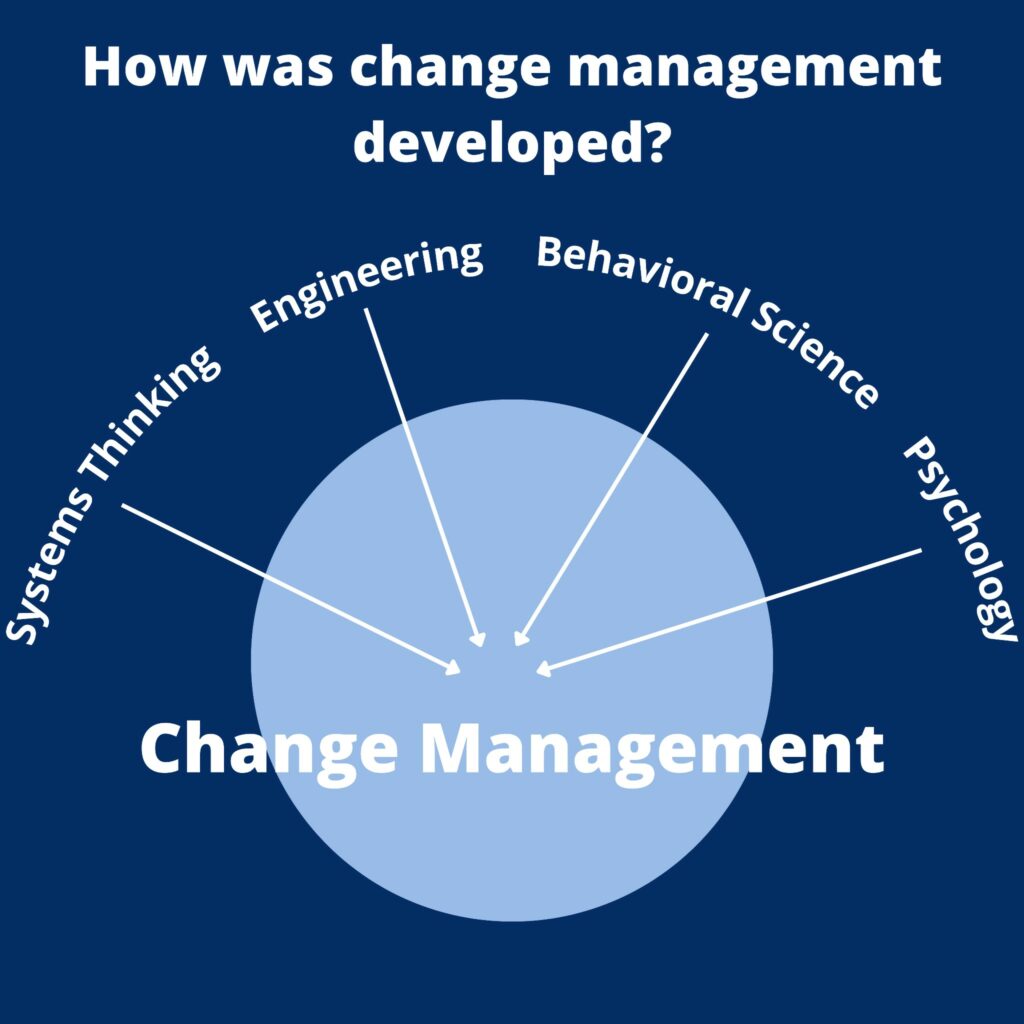
Several parts of change management are preparing and supporting employees that will be affected by the change, establishing steps for change, and monitoring activities before and after the change is implemented to ensure success.
A fundamental principle of change management is that it is not a reactive response to change. Instead, it’s proactive preparation for when change happens. When used correctly, it allows your organization to assess the situation at hand, align all of its resources and efforts, and manage the change itself.
Some of the most common situations in which you’ll need to use change management include the implementation of new technology, a shift in organizational culture or leadership, mergers and acquisitions, and times of crisis.

Levels of Change Management
Within the umbrella of change management are three general levels.
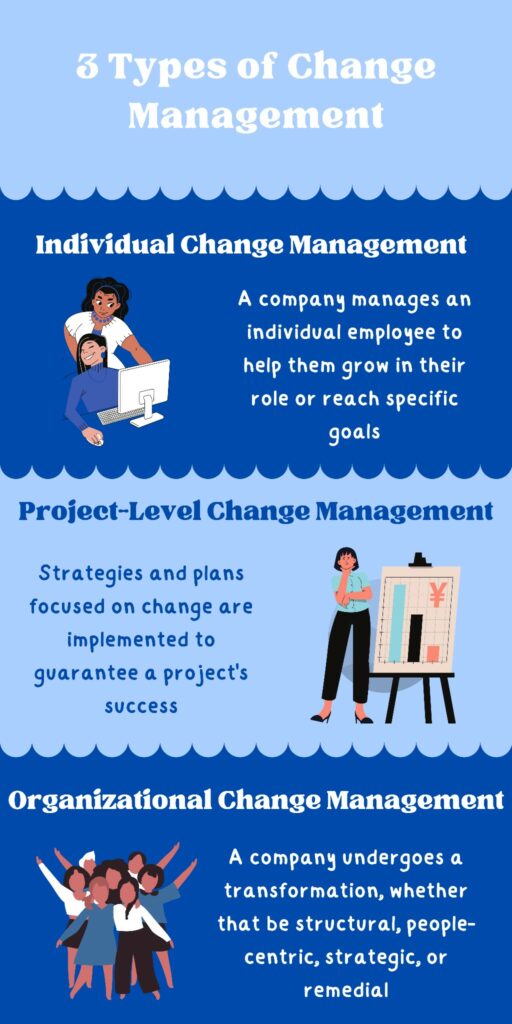
Individual Change Management
Individual change management is when the company manages an individual employee’s changes. You might do this to help the individual grow in their role or to aid them in achieving a specific goal.
Project-Level Change Management
Change management at the project level refers to strategies and plans focused on changes intended to guarantee a project reaches its intended goal.
Organizational Change Management
This is the most dramatic level of change management, and it refers to the ways that companies conduct transformations. A transformation could be integrating new software, introducing a new process, or altering the organizational hierarchy. There are four types of organizational change that you should address with organizational change management.
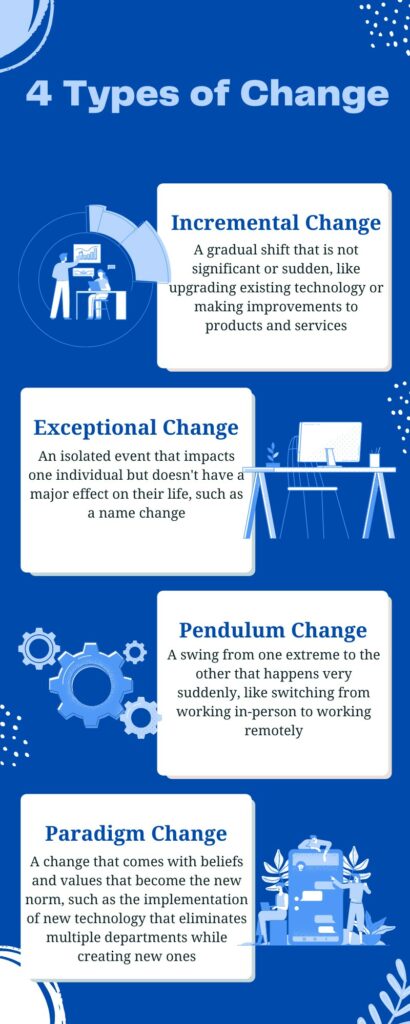
- Remedial Change – Remedial change occurs when unexpected problems arise that must be solved immediately. It involves reactionary corrections. Examples include addressing customer complaints and hiring a replacement for an employee who has put in their notice.
- People-Centric Change – This type of organizational change involves adjustments within the company that have a considerable effect on hiring new employees. A few people-centric changes are modifying the organization’s leave policies, hiring new employees, and redefining roles and responsibilities.
- Strategic Transformational Change – Strategic transformational change refers to large-scale changes that require significant organizational adjustments, e.g., an update to the company’s mission statement or a change in the employee benefits package.
- Structural Change – A structural change is quite significant and affects the organizational hierarchy. It’s most often caused by mergers and acquisitions.
Types of Change
The type of change management used depends on the kind of change occurring. There are four major ones to be aware of.

Incremental Change
An incremental change is gradual and doesn’t require a sudden or significant shift. Upgrading existing technology would be considered an incremental change.
Exceptional Change
This type of change refers to an isolated event that affects an individual’s experience, but doesn’t majorly impact many areas of their life. A name change, for instance, would involve completing HR paperwork and getting a new email address, but it wouldn’t affect an individual’s role in the organization.
Pendulum Change
A pendulum change is a sudden swing from one extreme to the other. One example that took place recently is when many organizations switched from a 100% in-person work environment to a 100% remote team.
Paradigm Change
A paradigm change involves changes resulting in new values or beliefs that become the company’s new norm. A successful shift from synchronous communication to a hybrid model involving both synchronous and asynchronous communication would be considered a paradigm change.
The Importance of Change Management
Why is change management so important? Well, switching telecom vendors or even renewing your company’s contract with the current vendor is sure to involve various changes, whether that be new hardware or software, a change in budget, or a switch to a new vendor rep.
The fact is that people, in general, are highly resistant to change. According to research, only 38% of people enjoy leaving their comfort zone, while the other 62% feel uncomfortable or even fearful when confronted with change.

Unfortunately for that 62%, change is very common. Gartner reports that the average organization has gone through five enterprise changes in the past three years, and 73% of organizations expect more change initiatives to come in the next three years.
Therefore, as uncomfortable as change within a company can be, it’s simply inevitable. As a result, it’s essential to have good change management strategies in place to help the implementation of change go as smoothly as possible.
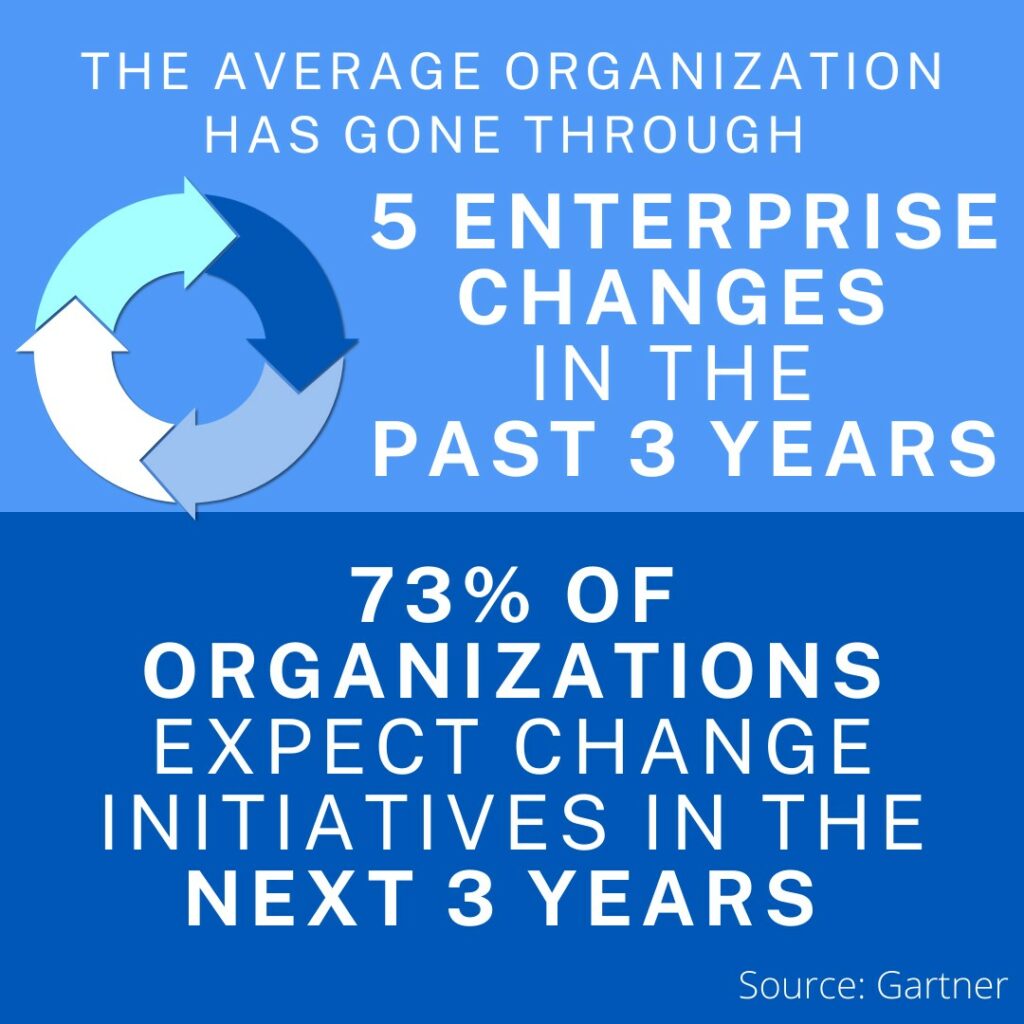
Differences in Organizations With and Without Change Management
With a plan for change management in place, a company is six times more likely to achieve its project objectives, five times more likely to stay on (or even ahead) of schedule, and twice as likely to stay on or under budget. Clearly, taking the time to strategize change management methods comes with plenty of benefits!
Let’s consider what an organization without effective change management strategies in place looks like.
Well, the employees are likely to feel surprised and even besieged by the unexpected shift. Projects may fail or require extended timelines and additional funding. And the change itself is unlikely to be adopted and used by more than a few employees.
Effective change management, however, creates strategies for successfully implementing change by addressing and balancing multiple aspects, including technology, people, and processes. Change management empowers employees, making them feel supported, prepared, and equipped to handle the change.
It proactively combats their resistance while setting goals for changes and monitoring the results. Projects are likely to stay on schedule, stick to their budgets, and meet their objectives. And any people-dependent return on investment is likely to be achieved.
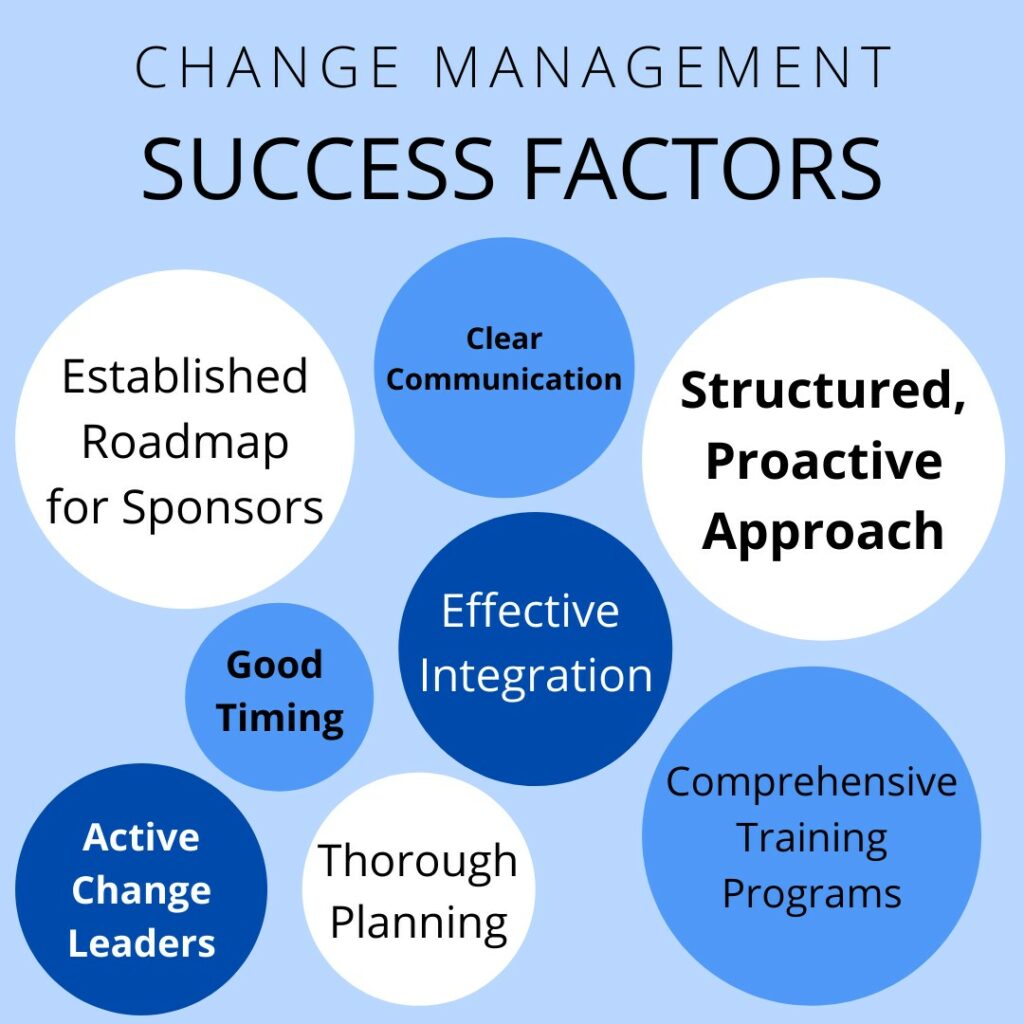
With change management, your organization will be able to adopt changes faster and more thoroughly with ultimate proficiency. Employees will fully understand why the change is occurring, and they’ll have the tools and time to get on board while feeling supported and heard throughout the process. They’ll remain engaged in the organization, even during disruptive change. When the principles of change management are applied before, during, and after a project, they can help immensely with achieving desired returns on project investments.
In need of guidance regarding data network or voice service procurement? Technology Procurement Group can provide the expertise and insight you need. Call us at 1-888-449-1580, email us at info@TPG-llc.com, or scroll down to fill out the form at the bottom of the page.
Strategies of Change Management
Many models and strategies can be used for change management. The best choice varies from company to company, so take the time to determine which will be the most effective for you.
The ADKAR Model
ADKAR is an acronym that lays out a framework for the change management process. It stands for Awareness, Desire, Knowledge, Ability, and Reinforcement.
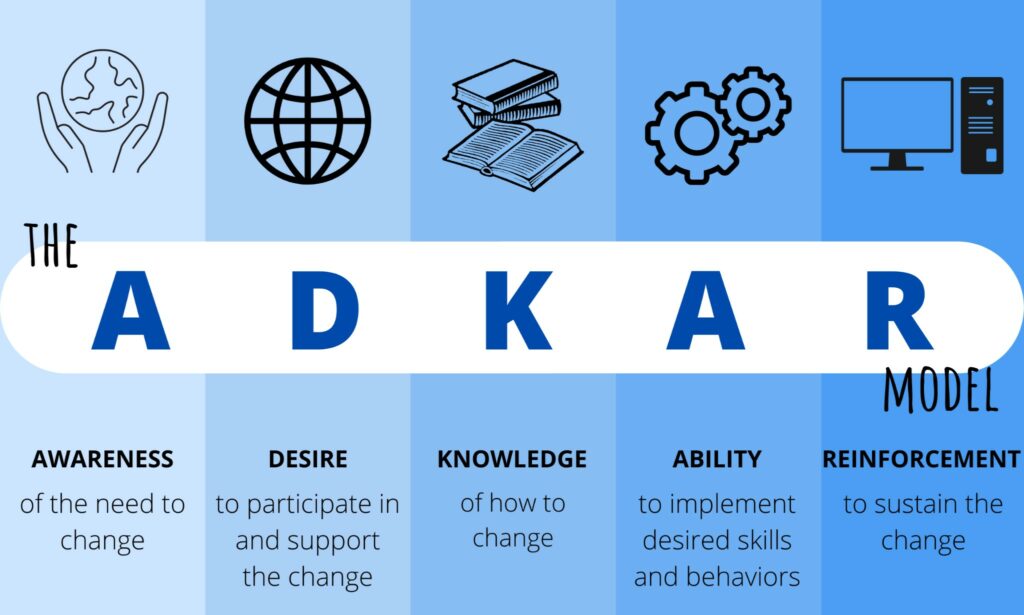
The Prosci Methodology
This change management methodology comprises three phases that address the periods before, during, and after the change.
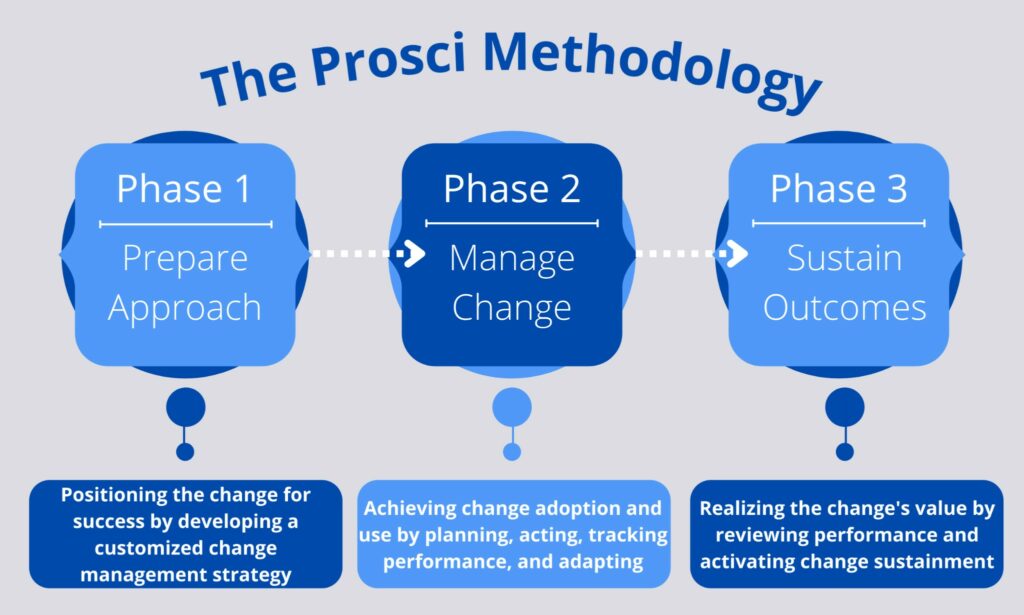
Phase 1 – Prepare Approach
In this phase, your company positions the change for success. It develops a customized, scaled change management strategy with the required commitment and sponsorship. Specific actions within this phase include defining success, impact, and approach.
Here are some questions to consider during this phase. Understanding the answers to these questions enables your company to promote the benefits of the change to come, defining success and impact.
- Why does our organization need to change?
- What are our company’s key objectives, and how will it measure success?
- How are the changes linked to our organization’s vision or mission statements?
- How will the change affect the way that employees work?
- How will the change impact people positively?
- What will employees need to do to achieve the change successfully?
- Does everyone involved understand what needs to happen and how it will affect them?
To define the approach to change, answer the following questions.
- How will our organization secure and use support and sponsorship?
- Who will help design and implement the change (internal or external resources)?
- How will our company win support from employees?
- Will “change agents” or a change management team be established?
- How are key stakeholders involved in the process?
- How will any training needs be addressed?
- What types of support will be offered throughout the process?
- What strategies will be used to change habits and establish new norms?
Phase 2 – Manage Change
This phase focuses on achieving the adoption and usage of the change. It functions by creating, implementing, and adapting plans that move your organization and employees through the ADKAR transitions (explained above). Within Phase 2, your organization plans and acts, tracks performance, and adapts its actions for the best results.
Phase 3 – Sustain Outcomes
The final phase of the Prosci Methodology centers on realizing the value of the change. During this phase, you’ll ensure the change is adopted by preparing and committing your organization to sustain it. During Phase 3, your organization reviews its performance, activates sustainment of the implemented change, and transfers ownership of newfound knowledge and assets attained through the change management process.
Kotter’s 8-Step Change Model
One of the most popular and widely-adopted change management theories globally, this model is divided into eight steps. Each focuses on a key principle associated with the way people respond to change.
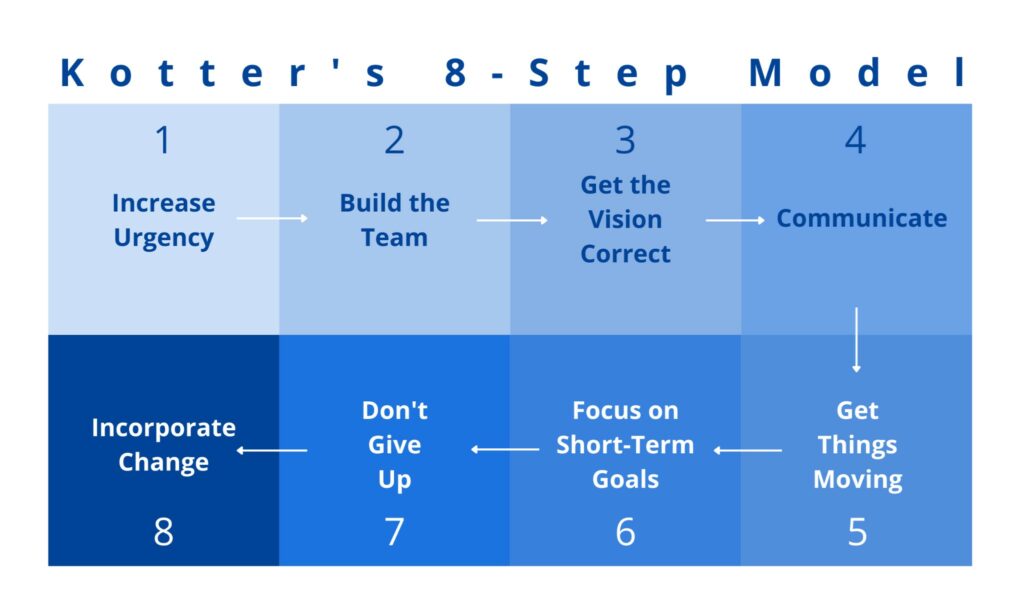
1. Increase Urgency
Create a sense of urgency among employees to motivate them to move toward objectives.
2. Build the Team
Select team members with a balanced mixture of skills, commitment, and knowledge.
3. Get the Vision Correct
Consider strategy as well as objectives, emotional connection, and creativity.
4. Communicate
Frequently engage in open communication regarding the change.
5. Get Things Moving
Remove roadblocks, get support, and implement constructive feedback.
6. Focus on Short-Term Goals
Set small, achievable goals to move toward success without too much pressure.
7. Don’t Give Up
Remain persistent throughout the change management process.
8. Incorporate Change
Make change a part of the organization’s culture with effective reinforcement.
Lewin’s Change Management Model
This change management model is divided into three stages: unfreeze, change, and refreeze.
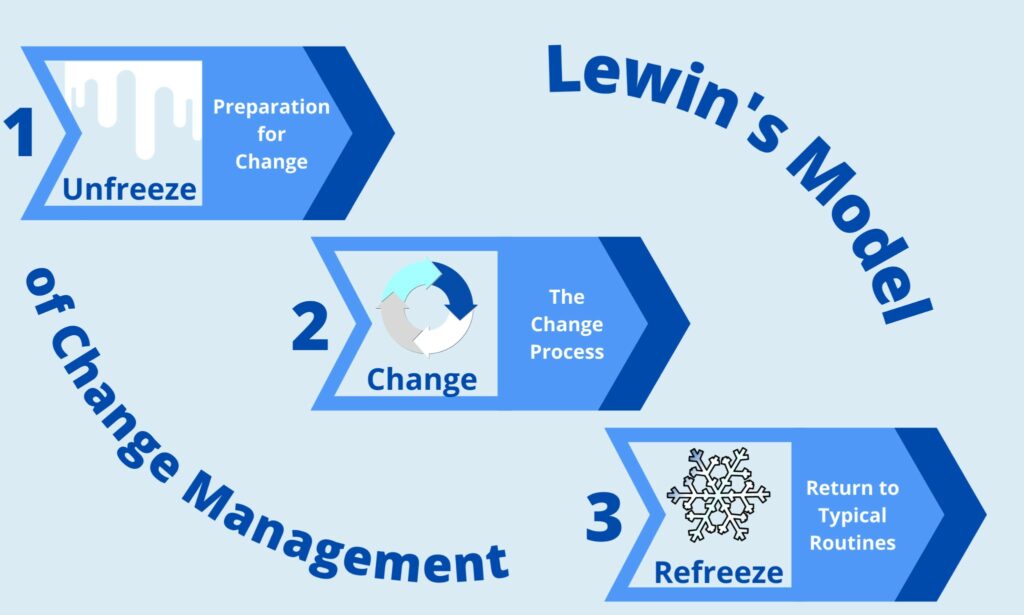
Unfreeze
During the Unfreeze stage, your organization prepares for change. Employers explain to employees what the change is and why it is necessary.
Change
The change process takes place during this stage. Effective communication and good leadership are crucial for success.
Refreeze
During the Refreeze stage, the change has been accepted, and employees return to their typical routines. Leaders must ensure that changes have been adopted and continue to be used after the change management objectives have been achieved.
General Principles for Successful Change Management
Regardless of the change management strategy you choose, these principles will help you find success.

Create a Climate that Embraces Change
Change is often intimidating and even frustrating. Creating a climate that’s receptive to change can make a huge difference in how it is received within the organization. Management can decrease employee resistance by effectively communicating the change to come so that everyone impacted is on the same page.
Providing a clear vision and remaining transparent regarding all of the “whys” and “hows” of the change results in increased employee trust and buy-in. This, in turn, helps employees become owners and implementers of the change.
Engage and Enable the Organization to Enact Change
Once a change-receptive climate has been established within the organization, it’s time to prepare by allocating responsibility. Perhaps the change necessitates a team for implementation. Or, if the change is an organizational one that will be enacted at multiple levels, it’ll be essential to establish responsibility for the coordination of the levels.
Establishing responsibility reduces ambiguity and guides the process, and it’s vital to keep communication clear and open. Another part of enabling the organization to enact change is celebrating short-term wins to maintain high morale.
Implement and Sustain Change
At this point in the change management process, the key is to maintain focus and pressure to achieve the organization’s desired outcome. All too often, a loss of focus occurs, and goals aren’t reached as a result. Be sure to adjust accordingly if changes in the target goal arise.
Review and Reflect on Change
This final principle should not be forgotten. Reviewing and reflecting on the change is key to determining the aspects of the process that worked, as well as those that didn’t go as planned. Documenting procedures, successes, and mistakes helps future change management teams approach the process confidently. This prepares the organization for improved success with future changes.
The Best Leadership Style for Change Management
The proper management style can have a hugely beneficial impact on change management. Here are several characteristics that successful change leaders typically display.
- Authenticity and strong communication skills
- The ability to inspire trust and build coalitions
- Emotional intelligence to understand employees’ personal difficulties and resistance to change
- The ability to think strategically, looking at the change in the context of the bigger picture
Change Management Best Practices
There are many ways to approach change management, but all of them involve these best practices.
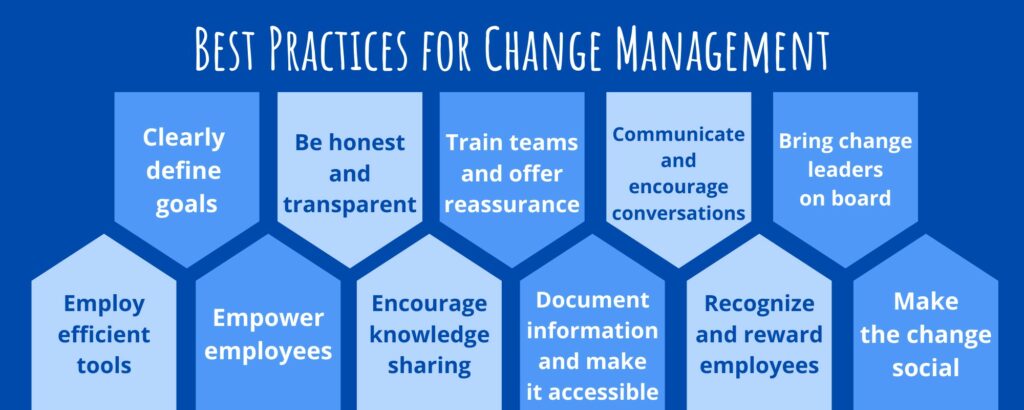
- Clearly define goals.
It can be difficult to establish clear goals for change management, but doing so ensures leaders and employees have something to reference throughout the process to stay on track.
- Maintain honesty and transparency.
Over a third of employees report that their employer isn’t always truthful. A lack of honesty and transparency during times of change can increase discomfort and distrust within the organization. Ensuring all employees understand what is happening each step of the way is crucial.
- Thoroughly train teams and offer reassurance.
Give employees the training and support needed to embrace the change at hand. Lead with empathy and reassurance. Allow enough time for them to adjust to new best practices.
- Communicate regularly and encourage conversations.
Employee relations play a huge role throughout the change management process. Remember that real communication goes both ways, not just one.

- Bring change leaders on board.
With excellent change management comes increased business outcomes of change initiatives. Providing the change leaders or team with information on the ROI of change management can help them get on board and support the change.
- Employ efficient communication tools.
Email is not always the most efficient way to communicate; many emails are never opened or read, and thus important information is lost. Online collaboration tools like Slack, Trello, and Microsoft Teams tend to be better, especially for companies with many employees from younger generations. It’s particularly helpful if the collaboration tool chosen is optimized for mobile use.
- Empower employees.
All employees should feel empowered to actively engage in the change process by implementing ideas and making decisions. When employees don’t feel empowered, they tend to be much less engaged and more resistant to change.
- Encourage knowledge sharing among employees.
Naturally, some employees will quickly adapt to change, while others will take more time. It’s been shown that knowledge sharing among employees can help to speed up this learning process quite a bit. Haiilo and other employee engagement and collaboration tools are an excellent way to enable knowledge sharing between employees.

- Document information and make it easily accessible.
Establish a central place where all important documents and information are kept and easily accessed by employees. Documentation is excellent, but if it’s not easily accessible, it’s not helping anyone.
- Recognize and reward employees.
More than three-fourths of employees say they’d work harder if they received recognition for their work. Recognizing and rewarding employees for accomplishments and adopting new behaviors is a fantastic way to keep them motivated during times of change.
- Make the change social.
If the company implements a new technology solution, sharing it publicly is a great idea. With modern communication tools, it’s easy for employees to share information inside and outside of the organization. Plus, employee advocates can help with recruitment and talent acquisition.
Roadblocks and Reasons Why Change Management Initiatives Fail
Unfortunately, change management initiatives can fail, and there are several common reasons for this. Establishing and sticking to a change management strategy and following the best practices described above can help to prevent these obstacles and issues.
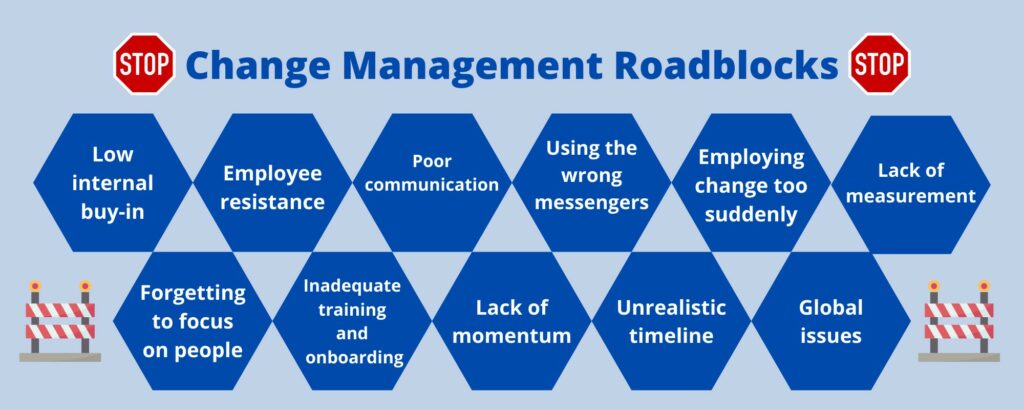
Low Level of Internal Buy-In
Change management initiatives require buy-in from leaders and employees alike, or they have no chance of success.
Employee Resistance
Reluctance to change is part of human nature, and it must be addressed accordingly. There are six stages of change readiness, starting with indifference and moving through rejection, doubt, neutrality, experimentation, and, finally, commitment.
To help employees move through these stages, assessments and self-evaluations can help by revealing in which areas work is necessary. To improve employee change readiness, leaders can develop strong senior sponsorship for people-focused work, coach employees, reward desired behaviors and outcomes, and rely on insights from those in the field.
Poor Communication
Employees must understand what the change is, why it is taking place, how it will affect them, and how it relates to the organization’s goals. Avoid vague communications and unexpected mandates for change. HR should be involved in motivating employees, and communications should be sent in multiple forms from multiple sources to ensure all critical information gets through.
Using the Wrong Messengers
Not only does information need to be communicated clearly and transparently, but it also needs to come from the right sources. Generally, employees trust information that comes from managers the most. HR or the senior executive team could also be good messengers, depending on the organization’s culture.
Employing Change Too Suddenly
Employees need plenty of time to prepare for change and provide feedback to leaders and managers before the change is initiated.
Lack of Measurement
It’s essential to define the way success looks for the company. Setting metrics and key performance indicators (KPIs) enables consistent procurement performance measurement.

Forgetting to Focus on People
Often, there is so much focus on the change itself that a focus on the people who will be affected is completely forgotten. There must be a focus on guiding employees through the transition.
Inadequate Training and Onboarding
Anytime new systems, software, hardware, or processes are introduced, sufficient training and onboarding are necessary for success. Provide ongoing, detailed training to employees during and after implementation.
Lack of Momentum
Rather than easing up on the change initiative too soon, keep enthusiasm high throughout the entire process in order to achieve objectives.
Unrealistic Timeline
Implementing effective change takes time and does not happen overnight. For change to stick, a realistic timeline is needed.
Global Issues
Conflict tends to be more likely to occur, as well as more difficult to address, in global organizations where there are differences in business practices, institutions, time zones, and languages. This is because culturally-based assumptions make it challenging to find common ground during cross-cultural change initiatives. A lack of a partnership approach, misreading of similarities and differences in markets, and lack of accountability can all contribute to global issues. Thus, these potential issues should be addressed in advance.
Technology Procurement Group Can Help

Whether you’re struggling to manage change associated with telecom procurement or need help strategizing your organization’s procurement process, TPG is here to make your life easier.
Not only do we offer telecom procurement strategy consulting and IT procurement services, but we can also provide telecom and wireless expense management, RFP management, wireless expense reduction, and telecom contract negotiation services.
Ready to work with us, or interested in getting more information? Call us at 1-888-449-1580, email us at info@TPG-llc.com, or fill out the simple form at the bottom of the page. We look forward to hearing from you!




